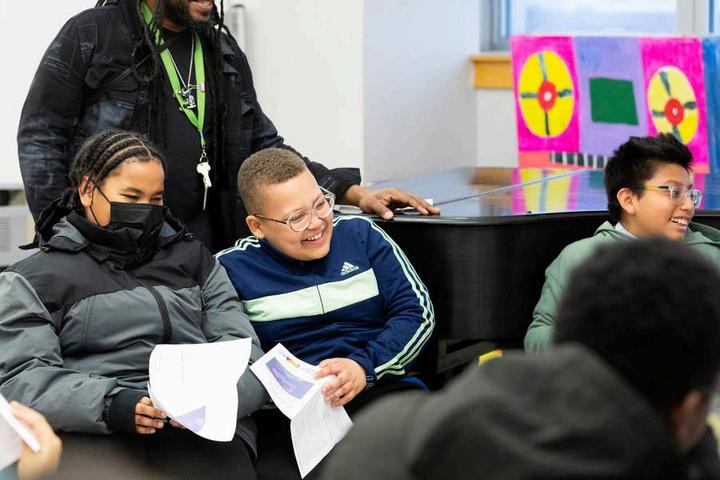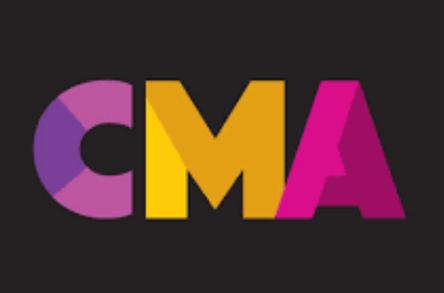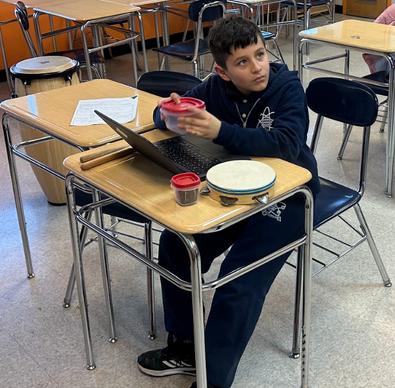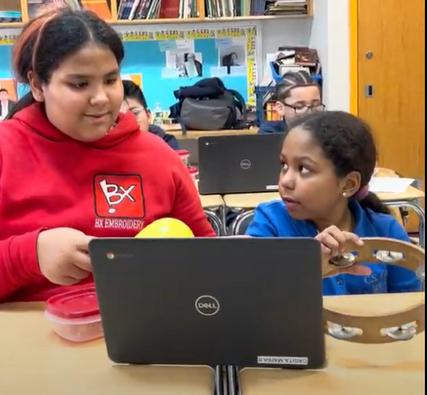SOUND JOURNEYS: IMPACT REPORT
CHAMBER MUSIC AMERICA & CASITA MARIA CENTER FOR ARTS AND EDUCATION
2
0
2
4

Overview

“Sound Journeys” is a six-week curriculum designed for 5th and 6th graders, celebrating the diverse aspects of chamber music crafted by contemporary composers of color.
Each week’s lesson centered around a musical concept (eg melody and harmony) and a complementary socioemotional skill (eg leading and collaboration). In this program, students developed their own minicompositions using percussion and found objects, culminating in a final sharing session.
Through a collaboration between Casita Maria Center for Arts & Education, Chamber Music America, and Sounds That Carry, this curriculum was piloted for Casita Maria’s afterschool program in Spring 2024 with two CMA teaching artists.
Development of Sound Journeys
Inspired by the Wallace Foundation’s Connected Arts Learning Framework, as well as the Creative Youth Development Framework that Casita Maria invokes, Sounds That Carry set out to create a curriculum that:
Represented the cultural identities of the young musicians
Prioritized opportunities for students to create their own music
Addressed stakeholder priorities and assessed for impact in these areas
Leveraged the resources of key partners
Additionally, CMA recruited and trained two teaching artists - Araceli Poma and Liz Hogg - to deliver the curriculum, increasing CMA’s capacity to engage with community partners in a meaningful way.

1 LEVERAGE RESOURCES
Leverage resources at Casita Maria and Chamber Music America to create a highly participatory, culturally-responsive afterschool chamber music curriculum for 5th and 6th graders at Casita Maria.
2 INCREASE CAPACITY
Broaden CMA’s community engagement capacity by hiring and training CMA musicians to be effective teaching artists, promoting the music and members supported by CMA.
3 ASSESS IMPACT
Measure impact dynamically and broadly, using the Connected Arts Learning Framework and recent research to assess socioemotional growth and community thriving.
CURRICULUM

Close Listening
Phonological Awareness
Melody/Accompaniment
Leading/Collaboration
Texture/Timbre
Embracing difference
Vocalization
Identity/Your Voice
Electronic Music
Innovation
Improvisation
Adaptibility
TEACHING ARTIST TRAINING
The intensive 2-day training focused on instructional techniques, classroom management, curriculum delivery, and cultural competency, followed by a tour led by Bronx Historical Tours

DAY 1:
Explore Casita Maria history
Understand K-12 music education in NYC, its priorities, and access gaps
Identify "expert biases" and leverage TAs lived experiences.
Develop an inquiry-based and adaptable teaching approach.
Practice music teaching fostering student composition and songwriting.
DAY 2:
Practice Say-See-Do and Active Participation techniques.

Employ classroom management techniques to mitigate bias
Learn how to support students in using digital audio workstations
Strategies for student self-regulation.
Techniques for student final projects (eg, field recordings, photos, reflection questions).
What ideas, techniques, or experiences will you use in your future teaching artist practice?
“I think all of it: new types of instruments, listening to more modern classical music by living composers and having kids use soundtrap specifically to compose are all things I would implement in general in my teaching practice.”
TEACHING ARTIST SELF-ASSESSMENT
We believe that teaching artists are not just delivering a service; they are honing their craft
We used self-assessments to monitor participant engagement and learning outcomes during sessions, guiding next steps for teacher development.


“I feel that I can have a program or guide as a reference for teaching, and at the same time, I can also contribute ideas or change something according to how the class unfolds.”

[I enjoyed] the curriculum: thinking outside of the box in terms of composing and what is considered music, as well as tailoring it to their specific backgrounds and environments
How can we continue to garner interest in teaching artistry among CMA members, and how can we adapt training to reflect their professional development goals?
INITIAL METRICS
Attendance
% of class time focused on active participation
Curricular Objectives Met
Lesson Plan Outline (example)
Week 1 - Melody & Accompaniment
Central Piece and Composer: Rhiannon Giddens - There is no other
Opening Activity Name Song
Active Listening & Discussion
Listen to central piece
write down three things the sounds make you think of... if this were a movie, what would it be about?
Group Composition Activity with Prompt
Using two different instruments in your station, create a 15-second piece with melody and accompaniment
Closing Activity
Exit ticket - students write down one artist or song to add to a classroom playlist
FINAL PRESENTATION
April 2nd, 2024

Students introduced their favorite sound and original group mini-compositions in a final sharing session, with CMA staff and Casita Maria community members in attendance.
Compositions included a combination of voice, percussion, and found objects. All those who participated showcased their learnings on Soundtrap through recording and presenting their compositions
11 out of 13 students presented a final composition (85%)
12 out of 13 students spoke to the audience on learnings (92%)
Presentations demonstrate:
Shared experience and connection to a new community
Boosted self-confidence and self-esteem
Promotion of teamwork and collaboration
Musical skill development
YOUTH VOICE
“Arts learning acts as a platform for youth to develop their perspectives, leadership abilities, and voices in public spaces.”
-Connected Arts Learning Framework The Wallace Foundation (2023)

Youth Voice was demonstrated through: original compositions and lyrics responses to self-reflective music-making prompts such as “what sounds represent your neighborhood?” student-led discussions about musical works
Number of students who expressed agency, autonomy, or leadership during class, such as leading an activity or presenting a new idea.
Insight: Youth Voice developed quickly during Week 4, as students were officially paired as “duos” for compositions Students had increased opportunity for self-directed learning
“[Martha] wanted to name 3 instruments she liked and offered to play her composition first.”
DOING WELL BY DOING ART
“Programs foster positive emotions through artmaking, such as feelings of self-esteem and selfworth. They also create spaces for youth to process negative emotions and trauma through art, often in ways that rely on and build relationships.”
-Connected Arts Learning Framework
The Wallace Foundation (2023)
Rationale
Sounds of My Neighborhood activity:

Collaboration as an indicator of self-esteem (10/13) 77%
Connection and celebration to place builds self-worth (11/13) 85%

NETWORKED ARTS


X“Networked arts support learning within and beyond the organization’s programming This approach leverages existing connections among community, families, educators, and working artists, giving young people access to more expansive networks and communities beyond one arts program.”
-Connected Arts Learning Framework
The Wallace Foundation (2023)

Networking experiences connect local organizations to one another, creating new ways to showcase youth work or performances
Programs support network building (teaching artists, CMA staff) and shared creative activity among young people, all growing youths’ social capital.
Wherever possible, young people are invited to return to community arts organizations to teach, lead, or advise the next generation.
How can we build upon this partnership to augment relationships between teachers, artists, students, and their families within and beyond CMA’s current programming?
PROGRAM DESIGN RUBRIC

Questions
to boost connected arts learning:
How are channels of communication kept open to support and sustain arts learning?
How do the goals of the arts program connect young people to opportunities beyond the program?
BROAD OUTCOMES

MUSICAL GROWTH
Development of technical skills voice percussion found objects soundtrap
Cultivation of creativity and innovation through composition

EMOTIONAL GROWTH
Increased self-expression (youth voice)
Exposure to diverse perspectives
Boosted self-confidence and selfesteem

SOCIAL AND CULTURAL BENEFITS
Promotion of teamwork and collaboration
Fostering a sense of belonging & connection
Exposure to musical cultures and traditions
Musical skills to share with community
“Connected arts learning puts arts education within the context of culture and community, offering an expansive and equity-oriented vision of the purpose of arts education -- to support both individual learning and community thriving. ” -The Wallace Foundation (2023)
SCALING OUTLINE
Three Sites in Three Boroughs
Six Teaching Artists (including Liz and Araceli)
Experienced TAs become Site Leaders and are paired with new Teaching Artists.
Site Leaders continue building their skills in:
Curriculum development
Lesson Adaptability
Data Gathering
Site Communication
Classroom management toolkits
Emotional Regulation and Trauma-Informed Resources and more!
Sounds That Carry:
Augments and Adapts Teaching Artist Training
Curricular and Assessment Development
Managing relationships between Guest Artists and TAs
Weekly resource for new TAs
Formative and Summative Data Analysis using best practices
Find opportunities to build long-term relationships between families, teaching artists, CMA and partners.

SOUNDJOURNEYS
FINDINGS AND REFLECTIONS
Engagement
Expanding engagement metrics beyond attendance to include socioemotional metrics allowed for an holistic program assessment
TAs and Casita Maria staff remarked on how “focused” the students were during class, particularly when creating music.
Barriers to full engagement included a range of comfort with verbal communication, learning differences, and absences.
How can CMA and STC work more efficiently with community partners ahead of time to assess the needs and resources of participants?
Teaching Artist Training
CMA artists are eager and willing to be teaching artists, as evidenced by application pool and self-assessments by Araceli and Liz
How can CMA introduce professional development opportunities for its members hoping to engage with communities in a meaningful way?
In future iterations, we suggest adding a “languages spoken” question to the application and concluding the search with face-to-face interviews.
Teaching Artist training would benefit from one to two more days of training and observation. High needs are lesson adaptability, augmenting a toolkit for classroom management, emotional regulation resources, trauma-informed teaching practices, and data gathering.
Students
Inspired by the idea of Networked Arts, this experience affirms that young people need to be thought as part of the community
How can CMA involve children and families in more offerings?
FUTURE OPPORTUNITIES
There is a strong potential for High Connected Arts Programming:
Build long-term relationships with youth and families
Build opportunities for students and their families to connect to CMA outside the classroom.
Invite family and student responses to shape curricula
Connect with students and families to network with CMA partners, e.g. support for composers to visit classrooms; more facetime with CMA stakeholders
What outcomes might CMA want to study?
As CMA’s creative engagement efforts expand, consider programming to include “system” level reach according to Wallace Foundation’s Tri-level Theory of Change (2021); e.g. job opportunities, continuous music-creation opportunities and more.


Casita Maria Center for Arts & Education (2024). Creative Youth Development (CYD) and Socioemotional Learning (SEL) Framework. https://www.casitamaria.org/our-framework
National Endowment for the Arts (2024). Measuring the Arts: Indicator B.3: Who Is Personally Creating or Performing Art?. https://www.arts.gov/sites/default/files/b3-report-202403.pdf
The Wallace Foundation (2023). Connected Arts Learning Framework. https://wallacefoundation.org/report/connected-arts-learningframework-expanded-view-purposes-and-possibilities-arts-learning
Every Hour Counts (2021). A Framework for Measurement, Continuous Improvement, and Equitable Measurement Systems. https://wallacefoundation.org/sites/default/files/2023-08/Every-HourCounts-Measurement-Framework.pdf
